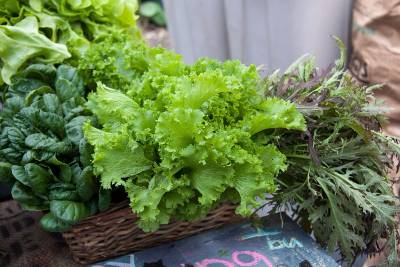Greens Packed with Nutrients and Phytochemicals
TEXARKANA, Ark. –
They may not be the most attractive vegetable, but if you are looking for a vegetable that packs a nutritional punch then greens are it. The deep green color of the leaves of greens is an indicator that greens are healthy. They are packed with nutrients and phytochemicals, substances found only in plants, which help fight diseases and improve health.
Researchers are finding that once we near the age of 65, there is some degree of vision loss. We can help slow that process by eating green vegetables rich in lutein, a powerful antioxidant found in green leafy vegetables that help maintain good vision and helps reduce the risk of cataracts and macular degeneration.
Greens not only contain lutein, they are also excellent sources of vitamins C, A, and E. Vitamin C helps the body absorb iron by making it more soluble and helps the body produce collagen, which helps form connective tissue that keeps skin firm and healthy. One half cup of mixed greens contains 28 percent recommended daily intake (RDI) of vitamin C, and 41 percent RDI of vitamin A, which helps with night vision.
Vitamin E, found mainly in turnip and collard greens, functions as an antioxidant that helps prevent heart disease and aging. It works by inhibiting blood cells from clumping together which can block arteries and reduces damage caused by free radicals that destroy connective tissue.
When purchasing fresh greens, look for young tender leaves. Choose smaller leaves, 6 to 12 inches long. The larger leaves indicate that they are older and are likely to be bitter. Greens should be fresh, tender crisp and of good green color. If they have brown or yellow spots, do not use them.
Because they are perishable, greens are best used right after purchase. To get the most nutritional value, use within 1 to 2 days of purchase. If you do need to store them, keep them in the coolest part of the refrigerator, unwashed, for 2 to 3 days. Storing them longer may cause loss of Vitamin C.
Greens tend to intimidate some because they may have heard how hard they are to clean, but it’s really not that difficult. Remove any rubber banding or ties to avoid damage. Wash greens by dipping in salted water (one to 2 teaspoons salt per gallon of water) and lift from water. Rinse well and repeat several times. Shake off excess water. If storing, spread on paper towels and pat dry.
Greens that are to be cooked before being added to a recipe can be steamed in a covered pot with only the water clinging to the leaves. One fourth cup water can be added if necessary.
To get your free copy of Enjoy Arkansas’ Fresh Greens, contact the University of Arkansas System Division of Agriculture in Miller County at 400 Laurel, Suite 215, call 870-779-3609, or e-mail me at chadley@uada.edu. Follow me on social media for more great tips at UAEX Miller County FCS/Carla Haley Hadley or twitter @MillerCountyFCS.
Greens will soon begin appearing at local farmers markets as well as in supermarkets and roadside stands.
Collard Greens with a Kick
- 1 tablespoon olive oil
- 3 slices bacon
- 1 large onion, chopped
- 2 cloves garlic, minced
- 1 teaspoon salt
- 1 teaspoon pepper
- 3 cups chicken broth
- 1 pinch red pepper flakes
- 1 pound fresh collard greens, cut into 2-inch pieces
Heat oil in a large pot over medium-high heat. Add bacon, and cook until crisp. Remove bacon from pan, crumble and return to the pan. Add onion, and cook until tender, about 5 minutes. Add garlic, and cook until just fragrant. Add collard greens, and fry until they start to wilt. Add in chicken broth, and season with salt, pepper, and red pepper flakes, Can add more if you want it hotter. Reduce heat to low, cover, and simmer for 45 minutes, or until greens are tender.
By Carla Haley-Hadley
County Extension Agent - FCS
The Cooperative Extension Service
U of A System Division of Agriculture
Media Contact: Carla Haley-Hadley
County Extension Agent - FCS
U of A Division of Agriculture
Cooperative Extension Service
400 Laurel Street, Suite 215 Texarkana AR 71854
(870) 779-3609
chaley@uada.edu
The Arkansas Cooperative Extension Service is an equal opportunity institution. If
you require a reasonable accommodation to participate or need materials in another
format, please contact your County Extension office (or other appropriate office)
as soon as possible. Dial 711 for Arkansas Relay.
Pursuant to 7 CFR § 15.3, the University of Arkansas System Division of Agriculture
offers all its Extension and Research programs and services (including employment)
without regard to race, color, sex, national origin, religion, age, disability, marital
or veteran status, genetic information, sexual preference, pregnancy or any other
legally protected status, and is an equal opportunity institution.
